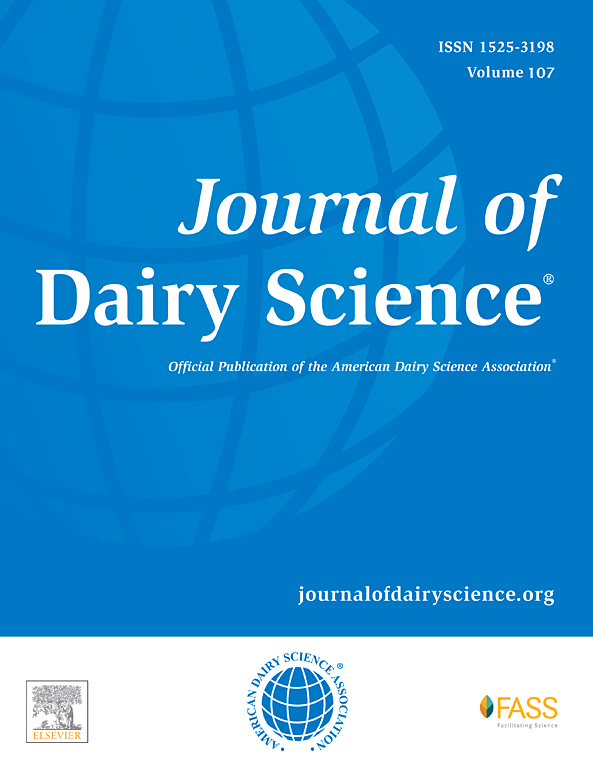Evaluation of ruminal outflow of protein and nitrogen fractions, and total and individual essential amino acid predictions, by nutritional models in dairy cattle
IF 4.4
1区 农林科学
Q1 AGRICULTURE, DAIRY & ANIMAL SCIENCE
引用次数: 0
Abstract
The objective was to evaluate the fit statistics for the predictions of ruminal outflow of protein fractions and EAA by the NRC, National Academies of Sciences, Engineering, and Medicine (NASEM), Cornell Net Carbohydrate and Protein System (CNCPS), and NittanyCow (NC) models in lactating dairy cows. Sixty-seven studies published in English between 1984 and 2020 with 251 treatment means were used for analysis. Lactational performance (DMI, DIM, milk yield, milk fat and true protein, and BW data), dietary nutrient composition (CP, NDF, ether extract, and ash), and ruminal outflow of total AA, microbial N, nonammonia nonmicrobial N, and individual EAA determined by omasal or duodenal digesta-sampling techniques were extracted from publications and used in the analysis when available. Production and dietary nutrient composition data reported in the studies were used as inputs to predict ruminal outflows of those same variables using NRC, NASEM, CNCPS, and NC models. For all nutritional models, dietary concentration (% DM) of CP was identical or allowed to vary by 0.5 percentage units maximum to that reported in the studies. Fit statistics and performances of nutritional models were assessed using Lin's concordance correlation coefficient (CCC), root mean squared error (RMSE, g/d and % of observed), as well as mean and linear biases. Models performed similarly when predicting ruminal total AA outflow, with CCC ranging from 49% to 57% and RMSE ranging from 19% to 30% of observed. Predictions of ruminal microbial CP (MicP) and nonammonia nonmicrobial CP (NANMCP) outflows had CCC ranging from 43% to 60% and RMSE ranging from 24% to 34% of observed. Predictions of Lys, Met, and His had CCC ranging from 38% to 62% and RMSE ranging from 23% to 40% observed. Overall, model-fit statistics indicated superior performance of NRC, NASEM, and NC in predicting all individual EAA outflows compared with CNCPS (except for Leu in NC). NittanyCow and NASEM, respectively, demonstrated superior performance in predicting total AA compared with NCR and CNCPS. Additionally, NC was superior to NRC and NASEM, which in turn were superior to CNCPS, in predicting ruminal MicP outflow. Both NRC and NC were superior to NASEM and CNCPS in predicting ruminal NANMCP outflow. The NASEM model was outperformed by NRC, CNCPS, and NC in predicting ruminal nonammonia N outflow. Mean and observed biases of concern (i.e., >5.0% of observed) were identified across all models, and these biases should be considered by nutritionists when balancing and evaluating rations targeting individual EAA in high-producing dairy cows.
利用营养模型评价奶牛瘤胃蛋白质和氮组分流出量以及总必需氨基酸和个体必需氨基酸的预测
目的是评估NRC、美国国家科学院、工程院和医学院(NASEM)、康奈尔净碳水化合物和蛋白质系统(CNCPS)和NittanyCow (NC)模型预测泌乳奶牛瘤胃蛋白质组分流出量和EAA的拟合统计。在1984年至2020年期间发表的67项英文研究中,有251种治疗方法被用于分析。泌乳性能(DMI、DIM、产奶量、乳脂和真蛋白以及体重数据)、饲粮营养成分(CP、NDF、粗脂肪和灰分)、瘤胃总氨基酸流出量、微生物氮、非氨非微生物氮和个体EAA(通过肛门或十二指肠食糜取样技术测定)均从出版物中提取,并在可用时用于分析。使用NRC、NASEM、CNCPS和NC模型,将研究中报告的产量和饲粮营养成分数据作为预测这些相同变量的瘤胃流出量的输入。在所有营养模型中,CP的日粮浓度(% DM)与研究报告相同或允许最大变化0.5个百分点单位。采用Lin’s一致性相关系数(CCC)、均方根误差(RMSE, g/d和% of observed)以及均值和线性偏倚来评估营养模型的拟合统计和性能。模型在预测瘤胃总AA流出量时表现相似,CCC范围为49%至57%,RMSE范围为19%至30%。瘤胃微生物CP (MicP)和非氨非微生物CP (NANMCP)流出量的预测CCC范围为43%至60%,RMSE范围为24%至34%。Lys、Met和His的预测CCC范围为38% ~ 62%,RMSE范围为23% ~ 40%。总体而言,模型拟合统计表明,与CNCPS相比,NRC、NASEM和NC在预测所有个体EAA流出方面表现优于CNCPS (NC中的Leu除外)。与NCR和CNCPS相比,NittanyCow和NASEM分别在预测总AA方面表现出更好的性能。此外,NC在预测瘤胃MicP流出方面优于NRC和NASEM,而NASEM又优于CNCPS。NRC和NC在预测瘤胃NANMCP流出方面均优于NASEM和CNCPS。NRC、CNCPS和NC模型在预测瘤胃非氨氮流出量方面优于NASEM模型。在所有模型中都确定了关注的平均偏差和观察偏差(即5.0%的观察偏差),营养学家在平衡和评估高产奶牛个体EAA的口粮时应考虑这些偏差。
本文章由计算机程序翻译,如有差异,请以英文原文为准。
求助全文
约1分钟内获得全文
求助全文
来源期刊

Journal of Dairy Science
农林科学-奶制品与动物科学
CiteScore
7.90
自引率
17.10%
发文量
784
审稿时长
4.2 months
期刊介绍:
The official journal of the American Dairy Science Association®, Journal of Dairy Science® (JDS) is the leading peer-reviewed general dairy research journal in the world. JDS readers represent education, industry, and government agencies in more than 70 countries with interests in biochemistry, breeding, economics, engineering, environment, food science, genetics, microbiology, nutrition, pathology, physiology, processing, public health, quality assurance, and sanitation.
 求助内容:
求助内容: 应助结果提醒方式:
应助结果提醒方式:


